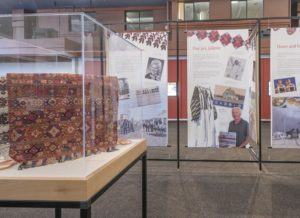In 2016, the Royal BC Museum partnered up with the Ukrainian Canadian Congress and Honorary Consulate of Ukraine in Vancouver to produce Bread & Salt, an installation that celebrated 125 years of Ukrainian immigration to Canada. Now, the exhibit is once more being displayed, updated to honour the most recent wave of displaced Ukrainians driven out by the Russia-Ukraine conflict. This time around, the exhibit is called Canada, Here We Are!, and it’s being presented free to the public at the museum.
The small exhibit consists of 14 panels describing the history of Ukrainian immigration to Canada, and features pictures and stories from the past 131 years, as well as an audio installation.
Ukrainian Canadian congress BC provincial council president Natalie Jatskevich says that she and the Ukrainian community wanted to share their history with Ukrainian immigrants and other Canadian residents.

“It wasn’t easy history, it was tough but very fruitful journey for us, so we wanted to share that history with the wider community, with the Canadians and with the visitors to Canada,” says Jatskevich. “Also, we wanted our new wave of immigration to know a little bit more about our history in Canada. Those 14 panels depict our lives, our steps of our long journey.”
Jatskevich says that the Ukrainian community emerged in Canada in 1891, when Vasyl Eleniak and a few followers arrived in Montreal, and proceeded to carve out an arduous life in the harsh wildlands.
“The first people who came here, they were mostly farmers, and they came with one or two suitcases, they brought everything they had back in Ukraine and with high hopes that they will be continuing their farming jobs in Canada,” she says. “The lands they got were quite difficult to work on, and many of the men that came, they had to go and work in different industries like mining, forestry, fishery, because they didn’t have enough resources to work on such tough lands, and women were left behind with kids to survive and to start building the first settlement.”
Jatskevich says the Ukrainian immigrants made a strong connection with the Cree tribes, and they shared each other’s cultures.
“[The Ukrainian women] wouldn’t survive if the First Nations people didn’t help them, and that’s a twist here, because the lands that Ukrainians were given, they were actually taken from First Nations people, who were displaced from those lands, but they didn’t hold anything against those Ukrainians, and they were helping those women survive,” Jatskevich says. “If you talk to First Nations Cree people, they will tell you many stories about how they did help each other, they offered each other’s shoulder and hand to survive, how First Nations people were learning from Ukrainian women on how to cook, how to make clothes, and Ukrainian women and families were learning from First Nations people how to hunt, how to work on this hard land and how to survive in such a harsh climate that they hadn’t encountered back in Ukraine.”
For the recent refugees fleeing war back home, Jatskevich hopes that learning of the history of their forebearers in Canada will give them hope for a strong future of mutual support.
“We really hope that many newcomers who are coming with this fifth wave of immigration, they can learn a lot from this exhibit, and they can also see that through whatever hardship life offers you, we stay strong,” says Jatskevich. “Communities stay strong, we survive, we support each other… and we are stronger together, and that’s one of the messages this exhibit brings. We are always stronger together.”
Canada, Here We Are!
Until Friday, January 6, 2023
Free, Royal BC Museum
rbcm.ca
